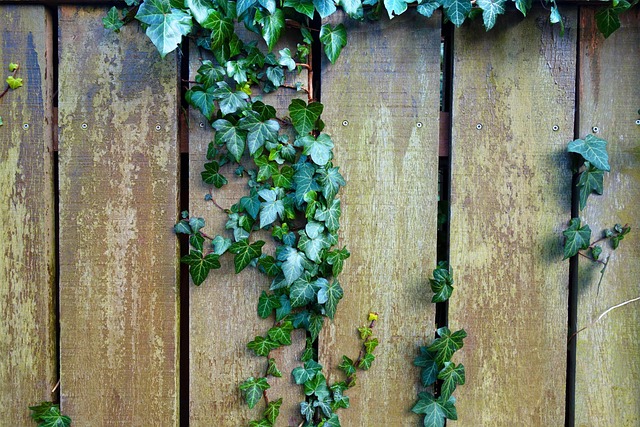Fences serve not only as boundaries but also as artistic elements defining your outdoor space. Fence staining and sealing are essential processes to protect and enhance wooden fences, ensuring they remain beautiful and durable for years. This guide delves into the art of fence staining, covering benefits and types, preparing your fence, choosing the perfect stain, application techniques, and concluding with sealing strategies for optimal longevity.
- Understanding Fence Staining: Benefits and Types
- Preparing Your Wooden Fence for Staining
- Choosing the Right Stain: Color and Formula
- Application Techniques for Even Coverage
- Sealing for Durability: Final Touches and Maintenance
Understanding Fence Staining: Benefits and Types
Fence staining is more than just adding color; it’s a protective coat that enhances the appearance and longevity of your wooden fence. The process involves applying a stain that seeps into the wood, enhancing its natural grain while also shielding against elements like UV rays, rain, and harsh sunlight that can break down and fade the finish over time.
There are various types of fence stains available in the market, each offering unique benefits. Water-based stains are popular for their low odor and ease of cleanup, while oil-based stains penetrate deeper to protect against rot and mold. Semi-transparent stains allow for a subtle color enhancement while still providing protection, while solid colors offer dramatic aesthetic changes and increased durability.
Preparing Your Wooden Fence for Staining
Before applying any stain or sealer to your wooden fence, proper preparation is key. Start by thoroughly cleaning the fence using a pressure washer or a stiff-bristled brush and mild detergent. This removes dirt, mold, and mildew, ensuring an even application of the finish. Inspect the wood for any damage, such as rot or loose boards, and repair these issues to prevent further complications. Sanding the fence slightly can also help with adhesion and create a smooth surface.
Remove any hardware, like latches or hinges, and protect them during the staining process. Cover nearby plants, pavers, or structures with drop cloths or plastic sheeting to avoid damage from over-spray. Make sure the weather forecast predicts clear, dry days for staining, as rain or high humidity can negatively impact the results.
Choosing the Right Stain: Color and Formula
Choosing the right stain is a crucial step in fence staining and sealing. When it comes to color, consider your fence’s existing tone and the overall aesthetic you want to achieve. Warmer tones like browns and reds can add depth and a rustic charm, while cooler grays and blacks provide a sleek, modern look. It’s essential to select a formula that suits your needs; semi-transparent stains offer subtle enhancement, allowing the wood grain to peek through, while solid colors create a more dramatic effect by completely covering the natural wood tone.
The formula also dictates how well the stain adheres to the wood and its longevity. Water-based stains are easy to apply and have low odor, making them popular choices. Oil-based formulas, on the other hand, provide deeper color and better protection against fading but may take longer to dry and have a stronger scent. Always check the product’s instructions for proper application and drying times, ensuring you choose a stain that aligns with your skill level and desired outcome.
Application Techniques for Even Coverage
For even coverage when staining and sealing your wooden fence, technique plays a significant role. Start by ensuring your fence is clean and free of any debris or previous sealers. This can be done with a pressure washer or a stiff brush and mild detergent. Once the surface is prepared, apply the stain evenly using a pad or brush, following the product’s instructions for recommended application methods. Move in straight lines, overlapping each section slightly to avoid streaking.
After staining, allow the surface to dry completely according to the manufacturer’s guidelines. Then, apply an even coat of sealer using a paint roller or brush. Similar to staining, maintain a steady pace and overlap sections by about 50% for uniform coverage. This meticulous approach ensures your fence not only looks great but also lasts longer, protecting against elements and enhancing its aesthetic appeal.
Sealing for Durability: Final Touches and Maintenance
After applying the fence stain, the final touches involve sealing the wood to enhance its durability and longevity. Sealing is a crucial step that protects the stained fence from the elements, including UV rays, rain, and humidity, which can fade or damage the finish over time. Choose a high-quality sealant designed for exterior use and suitable for wooden fences. Apply it evenly using a brush or roller, ensuring complete coverage. This protective layer not only adds aesthetic value but also acts as a barrier against dirt, mold, and mildew buildup.
Regular maintenance includes reapplying the seal every few years or as recommended by the product manufacturer. This simple step ensures your fence remains in excellent condition, preserving its color and texture. By keeping up with sealing, you can enjoy a beautifully stained fence for many years to come, knowing it’s shielded from the natural wear and tear that outdoor elements bring.
